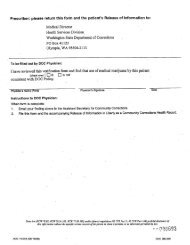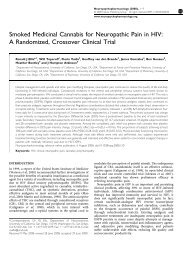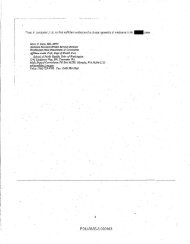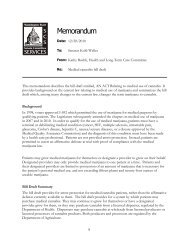Cannabis in painful HIV-associated sensory neuropathy
Cannabis in painful HIV-associated sensory neuropathy
Cannabis in painful HIV-associated sensory neuropathy
Create successful ePaper yourself
Turn your PDF publications into a flip-book with our unique Google optimized e-Paper software.
were low. The rigorous experimental pa<strong>in</strong> model outcomemeasures are novel to each patient and notstrongly <strong>associated</strong> with expectations of relief ofchronic pa<strong>in</strong>. Areas of secondary hyperalgesia aremapped by an <strong>in</strong>vestigator while the patient looksaway, and thus may be less subjective than pa<strong>in</strong><strong>in</strong>tensity rat<strong>in</strong>gs on a VAS scale. Therefore, thepresent study provides evidence that cannabis hasanalgesic effects on acute central neuronal sensitizationproduced by the experimental pa<strong>in</strong> model aswell as on the neuronal mechanisms <strong>associated</strong> withpa<strong>in</strong>ful <strong>HIV</strong>-SN.The results reported here <strong>in</strong> neuropathic pa<strong>in</strong> patientsexposed to an experimental pa<strong>in</strong> model areconsistent with precl<strong>in</strong>ical pa<strong>in</strong> model studies withcannab<strong>in</strong>oids. Systemic cannab<strong>in</strong>oids are effective <strong>in</strong>animal models of acute mechanical and thermalpa<strong>in</strong>, <strong>in</strong>flammation and hyperalgesia, and nerve<strong>in</strong>jury. 29-35 In healthy human volunteers, smokedcannabis <strong>in</strong>creased pressure pa<strong>in</strong> tolerance thresholds.36 The present study <strong>in</strong> chronic pa<strong>in</strong> patientsalso shows an effect on experimental hyperalgesia.Although smoked cannabis did not appear to suppressthe pa<strong>in</strong>fulness of the LTS procedure (analogousto the hot plate or tail flick test <strong>in</strong> animals),this may reflect the relatively low concentration ofdelta-9-THC <strong>in</strong> the study cigarettes.The cl<strong>in</strong>ical literature on cannab<strong>in</strong>oids for pa<strong>in</strong>conditions other than <strong>HIV</strong>-SN is limited and essentiallyrestricted to isolated delta-9-THC preparations.Fifteen and 20 mg of delta-9-THC producedsignificant analgesia <strong>in</strong> cancer patients with pa<strong>in</strong>, aswell as antiemesis and appetite stimulation, butsome patients reported unwanted side effects such assedation and depersonalization at the 20 mg doselevel. 37,38 In a follow-up study, 10 mg of delta-9-THCproduced analgesic effects comparable to 60 mg ofcode<strong>in</strong>e, and 20 mg of delta-9-THC was equivalent to120 mg of code<strong>in</strong>e. Two recent placebo-controlledstudies of cannab<strong>in</strong>oids for central neuropathic pa<strong>in</strong><strong>associated</strong> with multiple sclerosis produced resultssimilar to the present study. In a crossover trial ofsynthetic delta-9-THC up to 10 mg/day, an NNT of3.5 was reported. 39 A trial of a subl<strong>in</strong>gual spray conta<strong>in</strong><strong>in</strong>gdelta-9-THC alone or comb<strong>in</strong>ed with cannabidiolshowed a 41% pa<strong>in</strong> reduction with active drugvs a 22% reduction with placebo. 40The Institute of Medic<strong>in</strong>e report on cannabis andmedic<strong>in</strong>e concluded that cannab<strong>in</strong>oids likely have anatural role <strong>in</strong> pa<strong>in</strong> modulation, control of movement,and memory. 41 The Institute of Medic<strong>in</strong>e report,along with other recent reviews, suggest that ifcannabis compounds can be shown to have therapeuticvalue then the marg<strong>in</strong> of safety is acceptable. 42,43An acceptable safety marg<strong>in</strong> has been shown <strong>in</strong> thepresent study as well as <strong>in</strong> a previous study of cannab<strong>in</strong>oids<strong>in</strong> patients with <strong>HIV</strong>-1 <strong>in</strong>fection. 44AcknowledgmentThe authors thank study participants; the General Cl<strong>in</strong>ical ResearchCenter nurs<strong>in</strong>g staff; Sheila Huang, PharmD; Jessica Possehnand Marlene Berro from the Pa<strong>in</strong> Cl<strong>in</strong>ical Research Center;Joan Hilton, DSc, and Peter Bacchetti, PhD, at the UCSF Departmentof Biostatistics and Epidemiology; and Heather Bentley atthe University of California Center for Medic<strong>in</strong>al <strong>Cannabis</strong> Researchfor her assistance with regulatory affairs, data qualitymanagement, and <strong>in</strong>teraction with the Data Safety Monitor<strong>in</strong>gBoard.References1. So YT, Holtzman DM, Abrams DI, Olney RK. Peripheral <strong>neuropathy</strong><strong>associated</strong> with acquired immunodeficiency syndrome. Arch Neurol1988;45:945–948.2. Sacktor N. The epidemiology of human immunodeficiency virus<strong>associated</strong>neurological disease <strong>in</strong> the era of highly active retroviraltherapy. J Neurovirol 2002;8(suppl 2):115–121.3. McArthur JC, Brew BJ, Nath A. Neurological complications of <strong>HIV</strong><strong>in</strong>fection. Lancet Neurol 2005;4:543–555.4. Simpson DM, McArthur JC, Olney R, et al. Lamotrig<strong>in</strong>e for <strong>HIV</strong><strong>associated</strong>pa<strong>in</strong>ful <strong>sensory</strong> neuropathies: a placebo-controlled trial.Neurology 2003;60:1508–1514.5. Hahn K, Arendt G, Braun JS. A placebo-controlled trial of gabapent<strong>in</strong>for pa<strong>in</strong>ful <strong>HIV</strong>-<strong>associated</strong> <strong>sensory</strong> neuropathies. J Neurol 2004;251:1260–1266.6. Hugen PW, Burger DM, Br<strong>in</strong>kman K, et al. Carbamazep<strong>in</strong>e-<strong>in</strong>d<strong>in</strong>avir<strong>in</strong>teraction causes antiretroviral therapy failure. Ann Pharmacother2000;34:465–470.7. Simpson DM, Dorfman D, Olney RK, et al. Peptide T <strong>in</strong> the treatmentof pa<strong>in</strong>ful distal <strong>neuropathy</strong> <strong>associated</strong> with AIDS: results of a placebocontrolledtrial. Neurology 1996;47:1254–1259.8. Kemper CA, Kent G, Burton S, Deres<strong>in</strong>ski SC. Mexilet<strong>in</strong>e for <strong>HIV</strong><strong>in</strong>fectedpatients with pa<strong>in</strong>ful peripheral <strong>neuropathy</strong>: a double-bl<strong>in</strong>d,placebo-controlled, crossover treatment trial. J Acquir Immune DeficSyndr Hum Retrovirol 1998;19:367–372.9. Keiburtz K, Simpson D, Yiannoutsos C, et al. A randomized trial ofamitriptyl<strong>in</strong>e and mexilet<strong>in</strong>e for pa<strong>in</strong>ful <strong>neuropathy</strong> <strong>in</strong> <strong>HIV</strong> <strong>in</strong>fection.Neurology 1998;51:1682–1688.10. Shlay JC, Chaloner K, Max MG, et al. Acupuncture and amitriptyl<strong>in</strong>efor pa<strong>in</strong> due to <strong>HIV</strong>-related peripheral <strong>neuropathy</strong>: a randomized cl<strong>in</strong>icaltrial. JAMA 1998;280:1590–1595.11. Paice JA, Ferrans CE, Lashley FR, Shott S, Vizgirda V, Pitrak D.Topical capsaic<strong>in</strong> <strong>in</strong> the management of <strong>HIV</strong>-<strong>associated</strong> peripheral <strong>neuropathy</strong>.J Pa<strong>in</strong> Symptom Manage 2000;19:45–52.12. Calignano A, LaRana G, Giuffrida A, Piomelli D. Control of pa<strong>in</strong> <strong>in</strong>itiationby endogenous cannab<strong>in</strong>oids. Nature 1998;394:277–281.13. Walker JM, Huang SM. Cannab<strong>in</strong>oid analgesia. Pharmacol Ther 2002;95:127–135.14. Petersen KL, Maloney A, Hoke F, Dahl JB, Rowbotham MC. A randomizedstudy of the effect of oral lamotrig<strong>in</strong>e and hydromorphone on pa<strong>in</strong>and hyperalgesia follow<strong>in</strong>g heat/capsaic<strong>in</strong> sensitization. J Pa<strong>in</strong> 2003;4:400–406.15. Petersen KL, Rowbotham MC. A new human experimental pa<strong>in</strong> model:the heat/capsaic<strong>in</strong> sensitization model. Neuroreport 1999;10:1511–1516.16. Folt<strong>in</strong> RW, Fischman MW, Byrne MF. Effects of smoked cannabis onfood <strong>in</strong>take and body weight of humans liv<strong>in</strong>g <strong>in</strong> a residential laboratory.Appetite 1988;25:577–582.17. Petersen KL, Jones B, Segredo V, Dahl JB, Rowbotham MC. Effect ofremifentanil on pa<strong>in</strong> and secondary hyperalgesia <strong>associated</strong> with theheat-capsaic<strong>in</strong> sensitization model <strong>in</strong> healthy volunteers. Anesthesiology2001;94:15–20.18. Dirks J, Petersen KL, Rowbotham MC, Dahl JB. Gabapent<strong>in</strong> suppressescutaneous hyperalgesia follow<strong>in</strong>g heat/capsaic<strong>in</strong> sensitization.Anesthesiology 2002;97:102–107.19. Dirks K, Petersen KL, Dahl JB. The heat capsaic<strong>in</strong> sensitization model:a methodological study. J Pa<strong>in</strong> 2003;4:122–128.20. McNair DM, Lorr M, Droppleman LF. Manual for the Profile of MoodStates (POMS). San Diego: Educational and Industrial Test<strong>in</strong>g Service,1971.21. NIH Division of AIDS Table for Grad<strong>in</strong>g Severity of Adult AdverseExperiences, August 1992. Available at: http://rcc.tech-res-<strong>in</strong>tl.com/tox_tables.htm. Accessed March 6, 2006.22. Jay C, Shade S, Vizoso H, et al. The effect of smoked cannabis onchronic neuropathic and experimentally-<strong>in</strong>duced pa<strong>in</strong> <strong>in</strong> <strong>HIV</strong> <strong>neuropathy</strong>:results of an open-label pilot study. 11th Conference on Retrovirusesand Opportunistic Infections 2004: abstract 496:243.23. Farrar JT, Young JP Jr, LaMoreaux L, Werth JL, Poole RM. Cl<strong>in</strong>icalimportance of changes <strong>in</strong> chronic pa<strong>in</strong> <strong>in</strong>tensity measured on an 11-po<strong>in</strong>t numerical pa<strong>in</strong> rat<strong>in</strong>g scale. Pa<strong>in</strong> 2001;94:149–158.24. F<strong>in</strong>nerup NB, Otto M, McQuay HJ, Jensen TS, S<strong>in</strong>drup SH. Algorithmfor neuropathic pa<strong>in</strong> treatment: an evidence based proposal. Pa<strong>in</strong> 2005;118:289–305.25. Rowbotham M, Harden N, Stacey B, Bernste<strong>in</strong> P, Magnus-Miller L.Gabapent<strong>in</strong> for the treatment of postherpetic neuralgia: a randomizedcontrolled trial. JAMA 1998;280:1837–1842.520 NEUROLOGY 68 February 13, 2007
















